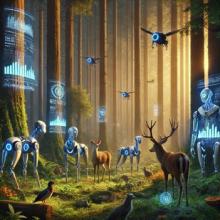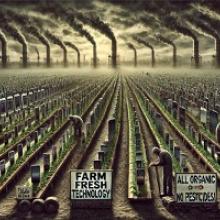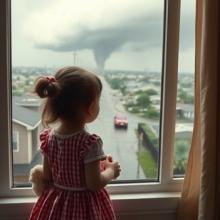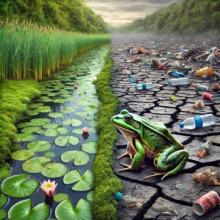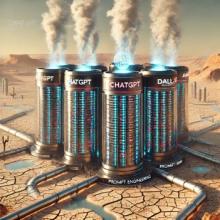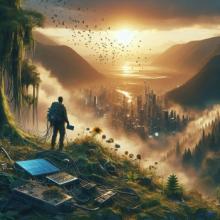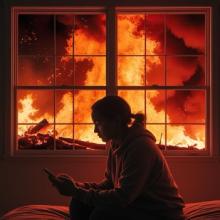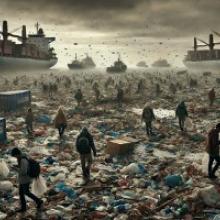We are thrilled to announce the results of our recent GeoAI Prompt Contest, a remarkable event that witnessed wide participation from the University of Washington community. This year’s contest received an impressive 55 submissions from universities and high schools across the United States, showcasing the incredible creativity and innovation of participants.
Choosing winners was no easy task given the exceptional quality of submissions. The submissions not only demonstrated the innovative capabilities of AI but also thoughtfully explored its social, environmental, and philosophical dimensions. These works are a testament to the transformative potential of GeoAI and the creative minds behind these contributions. Ultimately, we selected three winners, five honorable mentions, and two high school student awardees. By harnessing generative Artificial Intelligence, the contest fosters deep reflection and artistic expression concerning pressing issues such as climate change, food security, social and economic inequality, globalization, and more. The contest seeks to provoke reflection on the implications of AI, including the biases inherent in AI models and the societal impacts they may cause..
Organizing and judging an AI art contest presents unique challenges, given the complexity and depth of each piece. The artworks submitted were not only visually stunning but also carried profound meanings, making the selection process incredibly difficult. Our panel of judges, composed of undergraduate students, graduate students, staff, and faculty with expertise in Geography, GIS and AI, meticulously evaluated each submission. They based their decisions on a range of criteria, including Originality, Relevance to Theme, Artistic Expression, Technical Proficiency, and Emotional Impact & Message Conveyance.
It’s important to acknowledge that art is subjective, and each judge brought their own preferences and biases to the table. However, after careful consideration and spirited discussion, below is more information on the top awards.
1st place: Boundaries and Confusion: The Awkward Coexistence of AI and Nature
From Sohyun Han, University of Washington Department of Geography: Data Science
Author’s Description
This artwork depicts the process where AI robotic animals, developed through technological advancements, observe, protect, and collect data on endangered wildlife. These AI robots are equipped with adaptive learning abilities and non-threatening behaviors, allowing them to blend into the natural environment. However, real animals remain cautious and confused by their presence. Although the robots are non-aggressive and solely focused on observation, the animals feel awkward and uneasy in this situation, navigating the blurred boundaries between what is real and artificial. This artwork explores the potential for technological advancements to serve as tools for ecological protection and conservation while also visually expressing the social and philosophical questions and uncertainties that such innovations bring. Furthermore, the piece examines geographical issues such as climate change, biodiversity loss, and the impact of human technological intervention on ecosystems and habitats. Through this, the relationship between technology and nature, as well as the new social dynamics that arise from this interaction, is reimagined to highlight the critical geographical and environmental challenges we face today.
2nd Place: The Organic Growth of Digital Dependency
From Lili Pape, University of Southern California, Annenberg School of Communication and Journalism
Author’s Description
My piece symbolizes humanity’s increasing reliance on technology and the impact it has on critical global issues. Set in a dystopian landscape where smartphones grow like crops, tended by workers under a polluted sky, the piece visually critiques the environmental and social consequences of digital consumerism and rapid technological advancement. The industrial smokestacks represent pollution, emphasizing the environmental toll of electronic production on climate change. The signs proclaiming “Farm Fresh Technology” and “All Organic, No Pesticides” highlight the paradox of marketing products as "green" or "clean" while concealing their environmental costs. By depicting digital devices as crops, it questions the shifting priorities from essential resources, like food, to digital commodities, hinting at potential threats to food security. Finally, the laborers tending to the technology “plants” underscore social and economic inequalities, with people laboring to sustain a system that exploits both natural and human resources. Through this metaphor, the artwork warns against the unchecked spread of globalization and the risk of valuing technological growth over the health of our planet and people.
3rd place: The innocent youth
From University of Southern California
Author’s Description
This image aims to represent the fear and curiosity of the young generation of their uncertain future.
Honorable Mentions
Collaboration Over Competition
From Joan Isabelle Go, USC - SSCI Natural Disasters & Human Populations
There is, no doubt, that a considerable amount of disasters are caused or influenced by technologies – whether directly or indirectly. However, why don’t we focus less on going back and forth and pointing fingers at technologies, and instead, put more energy into discovering ways that advanced technology can prevent many types of disasters?
AI, GPT, The Thirsty Machine
From Zhijie Zhou, Department of Geography and GIS, University of Illinois Urbana-Champaign
In a world where technology thrives, the balance between innovation and sustainability has become increasingly precarious. “The Thirsty Machine” captures this tension, depicting a landscape where towering server farms dominate a desolate, semi-dystopian desert. Each server tower, adorned with AI-related labels like “ChatGPT,” “DALL·E,” and “Prompt Engineering,” serves as a stark reminder of the hidden costs of our digital age. As these systems consume vast amounts of water to sustain their operations, the image invites us to reflect on the environmental impact of our reliance on artificial intelligence. It prompts a critical conversation about how we can innovate responsibly while safeguarding our planet’s precious resources.
A Mother’s Burden
From Alex Hymson, University of Southern California
This artwork depicts Mother Earth, personified as Atlas, straining to bear the weight of a heavily polluted world. She represents both nature and humanity’s burden in preserving a livable future, with signs of industrial pollution—smog, smoke, and litter—visibly marking the globe. Beneath her stand children who symbolize future generations, gazing up in fear and concern. Their presence contrasts with the polluted Earth above them, illustrating the tension between our current environmental harm and the future that depends on today’s choices. The piece emphasizes pressing global issues, primarily climate change, which threatens natural ecosystems and human societies worldwide. The heavy, polluted Earth symbolizes industrial impacts on the environment, while the children below reflect the social inequalities that can result, with future generations inheriting the consequences of present actions. The image also hints at economic disparity and globalization; those most affected by climate change are often the least responsible for it, highlighting the unfair distribution of environmental harm. Ultimately, this artwork is a call for reflection and responsibility. It prompts viewers to consider how humanity’s current actions impact Earth and future generations, and to think critically about how to create sustainable and equitable solutions for all.
LOOK OUTSIDE
From Lillie O'Loughlin, University of Southern California
This piece of work is a visual depiction of climate change and humanity's ability to ignore the very changes happening outside their window.
Home Away from Home
From Logan Hosoda, University of Washington, College of Arts and Sciences & Information School
As someone who grew up on the island of Hawai'i, I witnessed first hand what it means to be "priced out of paradise". Historically, high demand areas often bought by tourists and foreign investors, drive up costs to make land unaffordable for locals, leaving them displaced by the places they used to call home. Often times, the motivation to buy land is solely for personal gain without realizing the impacts on cultures, sustainability, and economical inequity. Although my image does not feature Hawai'i directly, I hope that people will appreciate the beauty of nature and the importance of preservation. And to those who have been displaced due to economic challenges, remember that you'll always take a part of home with you.
Best High School Student Awards
The Pacific Garbage Patch: Consequences of Consumerism
Kingston Li
My artwork is based on a real phenomenon, the Great Pacific Garbage Patch. Currents in the Pacific Ocean have caused trash from countries in Asia and the Americas to gather, creating an enormous area of garbage and microplastics. The patch continues to grow every year, and as the population grows and consumerism continues to dominate American culture, trash will only accumulate faster and faster. Much of the waste is also not biodegradable, especially plastic, which continues to break down into smaller and smaller pieces. As of now, most of the waste is these microplastics, and although they're small, they are still very deadly to ocean life. My image reveals the dangers of excessive consumerism, with people walking on the sea of garbage, completely indifferent to how their inaction exacerbates pollution and waste. If we can't take responsibility for this enormous issue, the future depicted in my image might not be too far off.
A Place Once Called Home
Suri Li
I created this artwork out of a love for nature and a fascination with the creatures that make up our ecosystems, especially frogs. I learned that frogs are one of the first species to feel the effects of pollution. Frogs are very vulnerable to even small changes in their habitat. Therefore, I realize how much impact human’s actions can have on the world around us. This artwork is my way of speaking up for them. It’s not just about saving frogs; it’s about the bigger picture—protecting our ecosystems by reducing pollution and taking responsibility for the impact we have.
